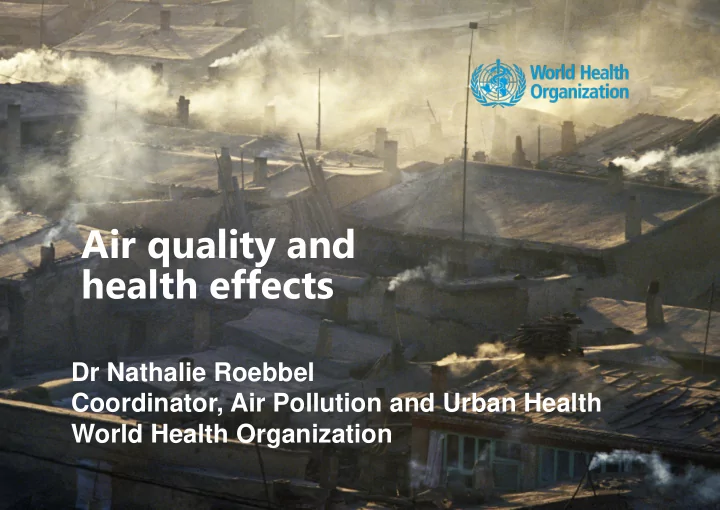

Air quality and health effects Dr Nathalie Roebbel Coordinator, Air Pollution and Urban Health World Health Organization
Air Pollution - one of the world ’ s largest single health risks
91% of the global population breathes polluted air
More than 3 billion people rely on polluting energy sources for cooking
Girls in households that cook with polluted fuels spent up to 35 hours a week collecting wood and water
Air pollution is affecting our health Ambient air pollution (AAP) 4.2 million deaths/yr Household air pollution (HAP) 3.8 million deaths/yr Joint effects of HAP and AAP 7 million deaths/yr In some areas, a significant fraction of ambient air pollution (AAP) is caused by household fuel combustion
What air pollution does to our lungs and our cardio- vascular system https://www.indiatoday.in/education-today/gk-current-affairs/story/air-pollution-839089-2016-10-20
Air pollution is the second leading cause of non-communicable diseases (NCDs)
From risks to solutions World Health Assembly Resolution A68.8 & Road Map
There are many solutions
Sustainable cities - Health at the heart of urban development Catalyze more effective urban action on air pollution and other urban health risks: Provide urban leaders with health and economic arguments Mapping policies Provide alternative scenarios Build competencies 9/10
WHO knowledge goods for the dialogue across sectors - Incorporating health in urban and territorial planning (with UN-Habitat, forthcoming) - Housing and Health Guidelines
Analytical tools to support Health and Economic Impact Assessments AirQ+ (air pollution) ISThAT (transportation) HEAT (walking and cycling) GreenS+ (green space) HOMES (household energy) Development and application of analytical tools to support the assessment of the health and economic impacts of interventions in key sectors, including on transport, household energy, green space and land-use, solid waste management (open source, flexible, evidence-based tools)
Strengthening local capacity on urban health and air pollution Regional training workshop on Environmental Health Capacity building activities as part of Urban Health Impact Assessment, CEHA, Amman, Jordan, 2017 Initiative pilot project in Kathmandu, 2018 Capacity building activities as part of Urban Health Initiative Urban Health Inittiative and BreatheLife training event at the pilot project in Accra, 2018 World Urban Forum, Kuala Lumpur, Malaysia, 2018
Addressing air pollution will have benefits for health and climate change
Expanding the knowledge base Evidence of effectiveness of sectoral policies Synthesis of cost-effectiveness analysis on air pollution / building the investment case Guidance to apply methodologies for cost- benefit analysis Updated and new guidelines and recommendations (sand, storms, low-cost sensors) Institutional capacity exists at the national and sub-national levels to conduct such analysis 4/10
Monitoring and reporting Enhanced global and regional monitoring and reporting on health trends associated with exposure to air pollution (SDG reporting) Expand database to other pollutants (e.g. NOx) WHO Global platform for air New partnerships (e.g. NASA) quality and health Disaggregated data Joint reporting (UN DESA / UN Habitat) This is informed by national and sub- national (e.g. city-level) monitoring efforts 5/10
Global leadership and coordination Link to NCD agenda at global, national and local level Build strong partnerships with all levels and sectors of society and intergovernmental organizations (WB etc.) Health as the pulse of urban policies National and sub-national plans on air pollution and health aligned with regional and global processes and frameworks 6/10
Institutional capacity strengthening Enhance health sector capacity for addressing adverse effects of air pollution (global, regional and country levels) including in the context of other sector policy processes Enhance capacities in HiAP- governance Develop capacities to implement new guidelines ( e.g. housing ) National and/or sub-national strategies developed to support such action 7/10
Expenditure on 96.4% Prevention and Public Health Services accounted for an estimated 3.6% of total health expenditures worldwide in 2013 Opportunity 5: Primary Prevention 3.6% Expenditure on Prevention & Public Total Expenditure on Health Health Services Source: WHO GHO, OECD , UK NHS, EIU, PHE Estimates
Our shared vision
Thank you ! Contact details: Tel.: +41 22 791 21 08 Email: roebbeln@who.int
Recommend
More recommend